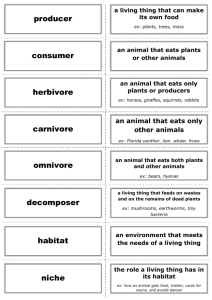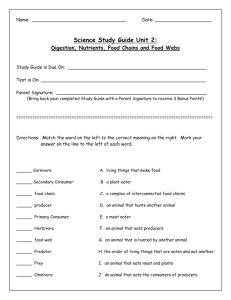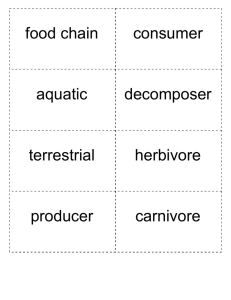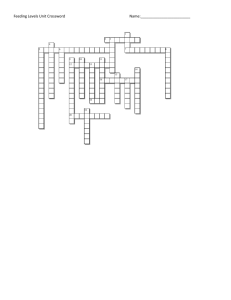Lexical Acquisition via Constraint Solving * Ted Pedersen
advertisement
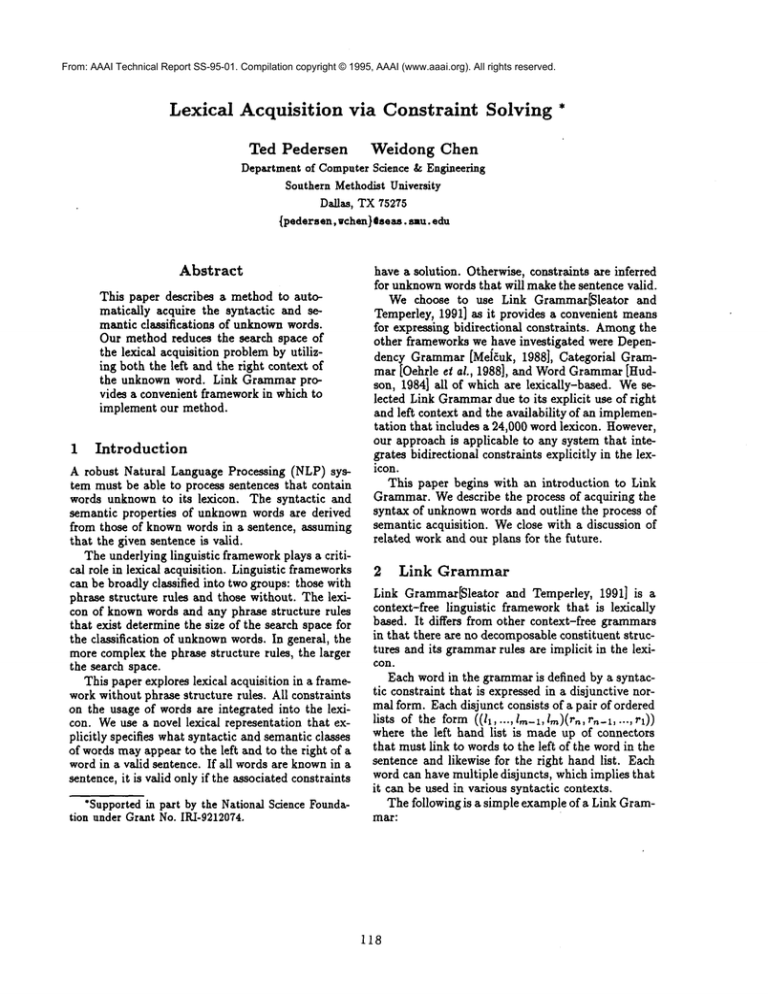
From: AAAI Technical Report SS-95-01. Compilation copyright © 1995, AAAI (www.aaai.org). All rights reserved.
Lexical Acquisition via Constraint Solving *
Ted Pedersen
Weidong Chen
Department
of Computer
Science
& Engineering
Southern
Methodist
University
Dallas,
TX 75275
{pedersen, wchen}eseas, smu. edu
Abstract
havea solution.
Otherwise,
constraints
areinferred
forunknown
wordsthatwillmakethesentence
valid.
Thispaperdescribes
a methodto autoWe choose to use Link Grammar[Sleatorand
matically
acquirethesyntactic
and seTemperley,
1991]as it provides
a convenient
means
manticclassifications
of unknown
words.
forexpressing
bidirectional
constraints.
Amongthe
Our methodreducesthe searchspaceof
otherframeworks
we haveinvestigated
wereDepenthelexical
acquisition
problem
by utilizdencyGrammar[Mel~uk,1988],CategorialGramingboththeleftandtherightcontext
of
mar[Oehrleet aI.,1988],and WordGrammar[Hudthe unknownword.Link Grammarproson,1984]allof whicharelexically-based.
We seridesa convenient
framework
in whichto
lected
LinkGrammar
dueto itsexplicit
useof right
implementour method.
andleftcontext
andtheavailability
of an implementation
thatincludes
a 24,000wordlexicon.
However,
ourapproach
is applicable
to anysystemthatinteIntroduction
1
grates
bidirectional
constraints
explicitly
in thelexA robustNaturalLanguageProcessing
(NLP)sys- icon.
Thispaperbeginswithan introduction
to Link
tem mustbe ableto process
sentences
thatcontain
We describe
theprocessof acquiring
the
wordsunknownto its lexicon.The syntacticand Grammar.
semantic
properties
of unknownwordsare derived syntaxof unknownwordsandoutlinetheprocessof
acquisition.
We closewitha discussion
of
fromthoseof knownwordsin a sentence,
assuming semantic
related work and our plans for the future.
thatthegivensentence
is valid.
Theunderlying
linguistic
framework
playsa criticalrolein lexical
acquisition.
Linguistic
frameworks2
Link Grammar
canbe broadly
classified
intotwogroups:
thosewith
phrasestructure
rulesandthosewithout.
Thelexi- Link Grammar[Sleator and Temperley, 1991] is a
con of knownwordsandany phrasestructure
rules context-free linguistic framework that is lexically
thatexistdetermine
thesizeofthesearch
spacefor based. It differs from other context-free grammars
constituent
structheclassification
of unknown
words.
In general,
the in thatthereareno decomposable
rulesareimplicit
in theleximorecomplex
thephrasestructure
rules,thelarger turesanditsgrammar
con.
thesearch
space.
Eachwordin thegrammar
is defined
by a syntacThispaperexplores
lexical
acquisition
in a frametic
constraint
that
is
expressed
in
a
disjunctive
norworkwithout
phrasestructure
rules.
Allconstraints
consists
ofa pairof ordered
on theusageof wordsareintegrated
intothelexi- realform.Eachdisjunct
oftheform((11,
...,/m-l,
Im)(rn,
m-l,...,
con.We usea novellexical
representation
thatex- lists
where
the
left
hand
list
is
made
up
of
connectors
plicitly
specifies
whatsyntactic
andsemantic
classes
that
must
link
to
words
to
the
left
of
the
wordinthe
of wordsmayappear
to theleftandto therightof a
sentence
andlikewise
fortherighthandlist.Each
wordin a validsentence.
If allwordsareknownina
disjuncts,
whichimplies
that
sentence,
itisvalidonlyiftheassociated
constraintswordcanhavemultiple
it canbe usedin various
syntactic
contexts.
Thefollowing
is a simpleexample
of a LinkGram*Supported
in partby theNational
Science
FoundationunderGrantNo.IRI-9212074.
mar:
118
big, yellow:
car, corn, condor,
gasoline, meat:
eats:
(() (A))
is to select one disjunct for each word in a sentence
that will lead to &atisfaction of the the meta-rules.
((A,D,,O,)
((X,Ds)
(Ss))
((Ds)(Ss))
((D,,O,)
(COs)
())
((ss)
(o))
ss)
())
() (D))
3
l(
the:
Parsing a sentence in Link Grammarconsists of
choosing one disjunct for each word such that it can
be connected to the surrounding words aa specified
in that disjunct. For a simple example consider the
sequence of words: The condor eats the meat" and
the following choices of disjuncts for each word from
the lexicon above:
the:
(() (D))
condor:
((Ds) (Ss))
eats:
((ss)
(o))
the:
meat:
(() (V))
((Ds,Os)
The following diagram (called a linkage) shows the
links amongthe words that justify the validity of the
sentence according to Link Grammar.
+ .... 08--+
+-Ds-+
I
1:he condor eL~s 1:he mea~
+-Ds--+-Ss--+
In general, a sequence of words is a sentence if it
is possible to draw links amongthe words in such
a way that the syntactic constraint of every word
is satisfied and all the following meta-rules are observed:
¯ Planarity: Links drawn above the sentence do
not intersect.
¯ Connectivity: There is a path from any word
in the sentence to any other word via the links.
¯ Ordering: For each disjunct of a word w, of the
form((iz, ..., In-z, l,n)(r,, m-x, ..., rx)),
m _> 0 and n >_ 0, the left hand list of connectors indicates links to words to the left of
w, and likewise for the right hand list. In addition, the larger the subscript of a connector,
the further away the word with the matching
connector is from w.
¯ Exclusion: No two links may connect the same
pair of words.
Parsing in Link Grammarcorresponds to constraint
solving according to these meta-rules. The objective
Syntactic Acquisition
Syntactic acquisition is the proce~ of mapping an
unknownword to a finite set of syntactic categories.
In Link Grammar syntactic categories are represented by the constraints that are expressed as disjuncts. Our lexical acquisition system is not called
upon to create or identify new syntactic categories
aa we assume that these are already known.
Given a sentence with unknown words the disjuncts of unknown words are determined based upon
the syntactic constraints of the knownwords in the
sentence.
For instance suppose that snipe is an unknown
word in the sentence: "The snipe eats meat". The
following lists all the choices for the disjuncts of the
known words which come from the lexicon.
the:
(() (D))
snipe:
((?) (?))
eats:
((s,)
(o))
((as)
meat:
((A,Ds,Os)
())
((A,Ds)
(Ss))
((Ds)(Ss))
((D,,O,)
())
((o,)
())
It must be determined what disjnnct associated
with ’snipe’ will allow for the selection of a single
disjunct for every known word such that each word
can have its disjtmct satisfied in accordance with
the meta-rules previously discussed. There are 10
distinct disjnncts in the above gr~,mmar and any one
of those could be the proper syntactic category for
’snipe’.
Wecould attempt to parse by blindly assigning
to ’snipe’ each of these disjuncts and see which led
to a valid linkage. Howeverthis is impractical since
more complicated grammars will have hundreds or
even thousands of known disjnncts. In fact, in the
current 24,000 word lexicon there are approximately
6,500 different syntactic constraints. A blind approach would assign all of these disjnncts to ’snipe’
and then attempt to parse. It is possible to greatly
reduce the number of candidate disjnncts by analyzing the disjuncts for the known words. Those disjuncts that violate the constraints of the meta-rules
are eliminated.
The disjuncts ((A,Ds)(Ss)) and ((Ds)(Ss))
’meat’ are immediately eliminated as they can never
be satisfied since there are no words to the right of
’meat’.
The disjunct ((A,Ds,Os)()) for ’meat’ can
be eliminated. If the A connector is to be satisfied
119
it would have to be sat/~ied by ’snipe’. The ordering meta-rule implies that the Ds connector in
’meat’ wouldhave to be satisfied by ’the’ but then
the remaining Os connector in ’meat’ would not be
satiMiable since there are no wordspreceding’the’.
That leaves the disjnncts ((Ds,Os)()) and
)) as the remainingpossibilities for ’meat’. Thedisjunct ((Ds,Os)()) can be eliminated since the
wordsthat can satisfy the Ds connector are ’the’or
’snipe’. Againthe ordering meta-ru/e makesit impossible to satisfy the Os connector. Thusthe only
remainingcandidate disjunct for ’meat’ is ((Os)()).
The next wordconsidered is ’eats’. There are two
pouihle disjuncts and neither can he immediately
eliminated. The left handside of each disjunct cons/sts of an Ss connector.This could only be satisfied
by ’snipe’ whichtherefore must havean Ss connector
in its right hand side. Recall that the left handside
of ’meat’ consists of an Os connector. This could be
satisfied either by the ((Ss)(O)) disjunct for ’eats’
if the right handside of ’snipe’ consists of ((Os,Ss)).
The left handside of ’snipe’ need only consist of a
Dconnector in order to satisfy the right hand s/de
of ’the’. Thus the disjunct for ’snipe’ must be either ((D)(Ss)) or ((D)(Os,Ss)) and wehave
eliminated any of the candidate disjuncts for ’eats’.
Unfortunately the meta-rules do not allow for the
further elimination of candidate disjuncts.
In cases suchas this the lexicon is usedaa a knowledgesource and will be used to resolve the issue. The
disjunct ((D)(Ss)) is selected for the word’snipe’
since it appearsin the lexicon and is normallyassociated with simple nouns. Thusthe disjnnct ((Ss)(O))
is the only possibility for ’eats’.
The disjunct ((D)(Os,Ss)) does not appear
lexicon and in fact implies that the word it is associated with is both a noun and a verb. To eliminate such nonsensical combinations of connectors
the lexicon of knownwordsis consulted to see if a
theorized disjnnct has been used with a knownword,
and if so it is accepted. Theintuition is that even
though a word is unknownit is likely to belong to
the same syntactic category as that of someknown
words. This follows from the assumption that the
set of syntactic categories is closed and will not be
addedto by the lexical acquisition system. For efficiency these constraints can be used to avoid the
generationof nonsensicaldisjuncts in the first place.
To summarize, the following assignment of dkjuncts satisfies the recta-rules andleads to the linkage shownbelow.
the:
snipe:
eats:
meat:
(()(S))
((D)(Ss)).
((Ss)(o))
+-Ds--+-Ss--+~Os-+
I
I
I
I
the snipe eal:s mea~
4 Semantic Acquisition
Acquisition of lexical semantics is defined in
[Berwick, 1983; Granger, 1977; Hastings, 1994; Rnssell, 1993] as mappingunknownwordsto knownconcepts. [Hastings, 1994; Russell, 1993] assumethat
the knowledgebase is a concept hierarchy structured
as a tree wherechildren are morespecific concepts
than their parents. There are separate hierarchies
for nouns and verbs. Rather than usin~ concept hierarchies [Berwick,1983; Granger,1977Jused scripts
and causal networks to represent a sequence of related events. In their workLexical Acquisition consists of mappingan unknown word into a knownsequence
of events. Weadopt the conventionof [Hastings, 1994; Russell, 1993Jand attempt to mapunknownwords into a concept hierarchy.
In order to semantically classify an unknown
word
the lexical entries of knownwords must be augmentedwith semantic information derived from the
actual usage of themin a variety of contexts.
As sentences with no unknownwords are parsed,
each connector in the syntactic constraints of nouns
and verbs is tagged with the nounor verb with which
it connects to. For instance given the sentence: "The
condor eats meat", the nouns and verbs are tagged
as follows:
the:
(() (D))
condor:
((D) ($8~,,,))
eats:
meat:
((Os..,,)
Whena wordoccurs
in zelated
syntactic
contexts
thesemantic
tagson thesyntactic
constraint~
are
merged
through
generalization
usingthesuperclass
information
contained
in thelexicon.
Suppose
that
thefollowing
sentences
withnounknown
words
have
beenprocessed.
$1:Thebigcoweatsyellow
corn.
$2:Thecondor
eatsmeat.
SO:Thecareatsgasoline.
Thecorresponding
semantic
tagsfor’eats’
are:
eats:
((Sso~,) (0o...))
((s,o..~..)
(o~..,))
((s~o..) (og..o,..))
Fromsentences
SI and$2 a moregeneral
semantic
constraint
islearned
since
’animal’
subsumes
’cow’and’condor’
and’food’
subsumes
’corn’
and
’meat’.
Thisknowledge
is expressed
by:
gl:
((Os)
120
(Oloo
))
((sso.,)(og...,..))
The semantic tags applied to the connectors serve
as semantic constraints on the words that ’eats’ connects to. The first disjunct in the above entry tells
us that ’eats’ must have a concept that is subsumed
by ’animal’ to its left and a concept that is subsumed
by ’food’ to its right.
While the lexicon has no information about the
unknownword it does have the semantic constraints
of the known words in the sentence. These are used
to infer what the semantic classification of the unknownword should be if the sentence is valid.
No semantic information has been acquired for
’snipe’. If the nouns and verbs in the sentence,
"The snipe eats meat~, are tagged with the nouns
and verbs that they connect to, the following is obtained:.
the:
snipe:
~ts:
meat:
(() (D))
((D) (Ss...))
((Se,.,p.)(0...o,))
((O,,,t,)
The lexicon has no knowledge of ’snipe’ but it
does have knowledge of the verb, ’eats’, that link~
to ’snipe’. It must be determined which of the two
usages of ’eats’ described in R1) applies to the usage
of ’eats’ in "The snipe eats meat".
According to the concept hierarchy ’meat’ is subsumed by ’food’ whereas ’gasoline’ is not. This indicates that the usage ((Ss=,,m=i)(O/ood)) more
appropriate and that ’snipe’ must therefore be tentatively classified as an animal. This classification can
be refined as other usages of ’snipe’ are encountered.
5
Discussion
There has been extensive work on lexical acquisition.
Probabilistic part-of-speech taggers have been succesdul in identifying the part-of-speech of vnknown
words[Church, 1988; Weischedel et ai., 1993]. These
approaches often require large amounts of manually
tagged text to use as tr~inlng data.
Unknownwords have been semantically classified
using knowledge intensive methods[Berwick, 1983;
Granger, 1977; Zernik, 1987]. They assume the
availability of scripts or other forms of detailed domain knowledge that must be manually constructed.
While they have considerable success in specific domains it is dlt~cult to port such systems to new
domains without requiring extensive manual customization for the new domain.
Explanation Based Learning has been applied to
lexical acquisition[Asker et al., 1992]. A large corpus of text is divided into sentences with unknown
words and those without. Those without are parsed
and their parse trees form a knowledgebase. Whena
sentence with an -nkuown word is processed the system locates the parse tree that most closely resembles it and attempts to infer the syntax of unknown
words from this tree. This approach assumes that
the sentences with knownwords produce parse trees
that will match or cover all of the sentences with
unknownwords. A limiting factor of this method is
the potentially large numberof distinct parse trees.
Unification-based
grammars have been brought
to bear on the problem of unknown words[Hastings,
1994; Russell, 1993]. These approaches are similsrin
that properties of I,nirnown words are inferred from
the lexicon and phrase structure rules. However, as
the underlying parsers work from left-to-right it is
natural to propagate information from known words
to unknownwords in the same direction.
The distinctive features to our approach are that
all the required knowledgeis represented explicitly
in the lexicon and constraint solving is bidirectional.
This makes maximal use of the constraints of known
words and reduces the search space for determining
the properties of unknown words. Link Grammaris
not the only way to process grammars bidirectionally. In fact, there is no reason why a more traditional context free grammar could not be processed
bidirectionally[Satta and Stock, 1994].
An implementation is under way to extend the
parser of Link Grammar to automatically acquire
the syntax and semantics of unknown words. It
seems that the disjuncts of each word are a special
kind of feature structure. An interesting topic is
to integrate feature structures and unification with
Link Grammarto allow more expressive handling of
semantic information.
References
[Asker et aL, 1992] L. Asker, B. Gamback, and
C. Samuelsson. EBL2 : An approach to automatic lexical acquisition.
In Proceedings of
the 14th International
Conference on Cornpnrational Linguistics (COLING-g~,), pages 11721176, Nantes, France, 1992.
[Berwick, 1983] It. Berwick. Learning word meanings from examples. In Proceedings of the 8th
International Joint Conference on Artificial Intelligence (IJCAI-83), volume 1, pages 459-461,
Karlsruhe, West Germany, August 1983.
[Church, 1988] K. Church. A stochastic parts program and noun phrase parser for unrestricted
text. In Proceedings of the Second Conference on
Applied Natural Language Processing, pages 136143, Austin, TX, 1988.
[Granger, 1977] It. Granger. FOUL-UP:A program
that figures out meanings of words from context.
121
In Proceedings of the ~e 5th International Joint
Conference on Ar~i~cial Intelligence (IJCAI-77),
volume 1, pages 172-178, Cambridge, MA, August 1977.
[Hastings, 1994] P. Hastings. Automatic Acquisition
of Word Meaning from Contez~. PhD thesis, The
University of Michigan, 1994.
[Hudson, 1984] R. Hudson. Won/Grammar. Basil
Blackwell, 1984.
[Me]~uk, 1988] I.A. Mei~uk. Dependency 5yntaz:
Theory and Practice. State University of New
York Pre~, 1988.
[Oehrle et aL, 1988] R. Oehrle, E. Bach, and
D. Wheeler, eclitors.
Categor~ai Grammarsand
Natural Language 5truc~ures. Reidel, Dordrecht,
The Netherlanck, 1988.
[Russell, 1993] D. Russell. Language Acqu~ition in
a Unificafion-Ba~ed Grammar Proces~ng System
Using a Real- World Knowledge Base. PhDthmis,
University of Illlnois at Urbana-Champalgn,1993.
[Sattaand Stock, 1994] G. Satta and O. Stock.
Bidirectional context-free grammar parsing for
natural language processing. Artificial Intelligence, 89:123-164, 1994.
[Sleator and Temperley, 1991] D. Sleator and
D. Temperley. Parsing English with a Link Grammar. Technical Report CMU-CS-91-196,Carnegie
Mellon University, October 1991.
[Weischedel et al., 1993] It. Weischedel, M. Meteer,
E. Schwartz, L. Rar~haw, and J. Palmucci. Coping with ambiguity and unknown words through
probabilistic
modek. Computational Lingu~fics,
19(2):359-382, June 1993.
[Zernik, 1987] U. Zernik. Language acquisition:
Learning a hierarchy of phrases. In Proceedings
of the lO~h International Joint Conference on Arti~cial Intelligence (IJCAI-87), volume 1, pages
125-132, Milan, Italy, August 1987.
122

